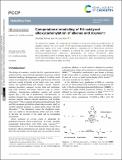Files in this item
Computational modelling of Pd-catalysed alkoxycarbonylation of alkenes and alkynes
Item metadata
| dc.contributor.author | Ahmad, Shahbaz | |
| dc.contributor.author | Buehl, Michael | |
| dc.date.accessioned | 2021-07-29T12:30:06Z | |
| dc.date.available | 2021-07-29T12:30:06Z | |
| dc.date.issued | 2021-08-14 | |
| dc.identifier | 275152730 | |
| dc.identifier | 203ab49c-fac2-445f-8a5d-08d45ce97c4a | |
| dc.identifier | 000677727400001 | |
| dc.identifier | 85112406639 | |
| dc.identifier.citation | Ahmad , S & Buehl , M 2021 , ' Computational modelling of Pd-catalysed alkoxycarbonylation of alkenes and alkynes ' , Physical Chemistry Chemical Physics , vol. 23 , no. 30 , pp. 15869-15880 . https://doi.org/10.1039/D1CP02426D | en |
| dc.identifier.issn | 1463-9076 | |
| dc.identifier.uri | https://hdl.handle.net/10023/23678 | |
| dc.description | The work was supported by the School of Chemistry and EaStCHEM. | en |
| dc.description.abstract | This perspective highlights the computational modelling of alkene and alkyne alkoxycarbonylation at palladium catalysts. We cover studies on Pd-catalysed alkoxycarbonylation of alkenes with bidentate diphosphine ligands, which reveal a hydride pathway is operating with an intermolecular alcoholysis step, where explicit solvation is mandatory to estimate the overall barriers correctly and model alcoholysis/copolymerisation selectivities. Subsequently, we discuss Pd-catalysed alkyne alkoxycarbonylation with P,N-chelating ligands, where an in situ base mechanism is operating involving ketene-type intermediates. We also discuss catalyst poisoning due to allene and designing a potential new catalyst tolerant towards allene poisoning. | |
| dc.format.extent | 12 | |
| dc.format.extent | 4033491 | |
| dc.language.iso | eng | |
| dc.relation.ispartof | Physical Chemistry Chemical Physics | en |
| dc.subject | QD Chemistry | en |
| dc.subject.lcc | QD | en |
| dc.title | Computational modelling of Pd-catalysed alkoxycarbonylation of alkenes and alkynes | en |
| dc.type | Journal item | en |
| dc.contributor.institution | University of St Andrews. School of Chemistry | en |
| dc.contributor.institution | University of St Andrews. EaSTCHEM | en |
| dc.identifier.doi | 10.1039/D1CP02426D | |
| dc.description.status | Peer reviewed | en |
This item appears in the following Collection(s)
Items in the St Andrews Research Repository are protected by copyright, with all rights reserved, unless otherwise indicated.

